Sedum
Sedum is a large genus of flowering plants in the family Crassulaceae, members of which are commonly known as stonecrops. The genus has been described as containing up to 600 species[2] updated to 470.[3] They are leaf succulents found primarily in the Northern Hemisphere, but extending into the southern hemisphere in Africa and South America.[3] The plants vary from annual and creeping herbs to shrubs. The plants have water-storing leaves. The flowers usually have five petals, seldom four or six. There are typically twice as many stamens as petals.
Various species formerly classified as Sedum are now in the segregate genera Hylotelephium and Rhodiola.
Well-known European Sedums are Sedum acre, Sedum album, Sedum dasyphyllum, Sedum reflexum (also known as Sedum rupestre) and Sedum hispanicum.
Taxonomy
Sedum demonstrates a wide variation in chromosome numbers, and polyploidy is common. Chromosome number is an important taxonomic feature. ('t Hart 1985) Linnaeus originally described 16 species of European Sedum.[4] There are now thought to be approximately 55 European species.[5]
Species
- Sedum acre L. – Wall-pepper, Goldmoss Sedum, Goldmoss Stonecrop, Biting Stonecrop
- Sedum actinocarpum
- Sedum aetnense Tin.
- Sedum aizoon – Aizoon stonecrop
- Sedum alamosanum
- Sedum albomarginatum Clausen – Feather River stonecrop
- Sedum album L. – White Stonecrop
- Sedum alfredii
- Sedum allantoides
- Sedum allantoides var. goldii
- Sedum alpestre Vill.
- Sedum alsinefolium
- Sedum amplexicaule DC.
- Sedum anacampseros – Love-restorer
- Sedum andegavense
- Sedum anglicum – English stonecrop
- Sedum annuum L. – Annual stonecrop
- Sedum aoikon
- Sedum apoleipon 't Hart
- Sedum atratum L. – Dark stonecrop
- Sedum australe
- Sedum backebergii
- Sedum baileyi
- Sedum barbeyi
- Sedum batallae
- Sedum batesii
- Sedum beauverdii
- Sedum bellum
- Sedum bergeri
- Sedum bithynicum – Turkish sedum
- Sedum blepharophyllum
- Sedum bonnieri
- Sedum booleanum
- Sedum borissovae
- Sedum borschii
- Sedum botteri
- Sedum bourgaei
- Sedum brandtiana
- Sedum brevifolium
- Sedum bulbiferum
- Sedum burrito – Baby burro's-tail
- Sedum caducum
- Sedum caeruleum
- Sedum caespitosum (Cav.) DC.
- Sedum calcaratum
- Sedum calcicola
- Sedum candolleanum
- Sedum candollei
- Sedum catorce
- Sedum cauticola
- Sedum celatum
- Sedum celiae
- Sedum cepaea L. – Pink stonecrop
- Sedum cespitosum
- Sedum chazaroi P.Carrillo & J.A. Lomelí
- Sedum chauveaudii
- Sedum chihuahuense
- Sedum chingtungense
- Sedum chloropetalum
- Sedum chrysicaulum
- Sedum chuhsingense
- Sedum clausenii
- Sedum clavatum
- Sedum clavifolium
- Sedum cockerellii Britt. – Cockerell's stonecrop
- Sedum commixtum
- Sedum compactum
- Sedum compressum
- Sedum concarpum
- Sedum confertiflorum
- Sedum confusum – Lesser Mexican-stonecrop
- Sedum conzattii
- Sedum confertiflorum Boiss.
- Sedum copalense
- Sedum cormiferum
- Sedum correptum
- Sedum corynephyllum
- Sedum constantinii
- Sedum craigii
- Sedum crassularia
- Sedum cremnophila
- Sedum cremnophila
- Sedum creticum Presl
- Sedum cryptomerioides
- Sedum cupressoides
- Sedum cuspidatum
- Sedum cyaneum
- Sedum cymatophyllum
- Sedum cyprium
- Sedum daigremontanum
- Sedum dasyphyllum L. – Thick-leaved stonecrop
- Sedum debile S.Watson – Orpine stonecrop, weakstem stonecrop
- Sedum decipiens
- Sedum decumbens
- Sedum dendroideum Moc. & Sessé ex A.DC. – Tree stonecrop
- Sedum didymocalyx
- Sedum dielsii
- Sedum diffusum S.Watson
- Sedum diminutum
- Sedum demorhpophyllum
- Sedum dispermum
- Sedum divergens S.Watson – Spreading stonecrop
- Sedum dongzhiense
- Sedum drymarioides
- Sedum dugueyi
- Sedum dulcinomen
- Sedum eastwoodiae (Britt.) Berger – Red Mountain stonecrop
- Sedum ellacombeanum – Stonecrop
- Sedum ewersii
- Sedum erythrostictum syn. Hylotelephium erythrostictum
- Sedum fosterianum – Rock stonecrop
- Sedum furfuraceum
- Sedum glaucophyllum Clausen – Cliff stonecrop
- Sedum grisebachii Boiss. & Heldr
- Sedum havardii Rose – Havard's stonecrop
- Sedum hirsutum
- Sedum hispanicum L. – Spanish stonecrop
- Sedum hybridum – Hybrid stonecrop
- Sedum iaconicum Boiss.
- Sedum integrifolium Entireleaf stonecrop
- Sedum iwarenge
- Sedum japonicum – Tokyo Sun stonecrop
- Sedum kamtschaticum Fisch. & C.A.Mey. – Orange stonecrop, Kamschatka stonecrop
- Sedum kostovii
- Sedum kamtschaticum cv. 'Weihenstephaner Gold' (formerly Sedum floriferum)
- Sedum lampusae (Kotschy) Boiss.
- Sedum lanceolatum Torr. – Lance-leaf stonecrop, lanceleaf stonecrop, spearleaf stonecrop
- Sedum laxum (Britt.) Berger – Roseflower stonecrop
- Sedum leibergii Britt. – Leiberg stonecrop
- Sedum liebmannianum
- Sedum lineare – Needle stonecrop
- Sedum litoreum Guss.
- Sedum lucidum
- Sedum lydium – Least stonecrop
- Sedum magellense Ten.
- Sedum makinoi Golden Japanese sedum
- Sedum mexicanum Britt. – Mexican stonecrop
- Sedum microstachyum (Kotschy) Boiss. – Small-spiked stonecrop
- Sedum moranense – Red stonecrop
- Sedum moranense Kunth – Red stonecrop
- Sedum moranii Clausen – Rogue River stonecrop
- Sedum morganianum – Donkey tail, burro tail
- Sedum multiceps – Pygmy Joshua tree, dwarf Joshua tree
- Sedum nanifolium Fröd. – Dwarf stonecrop
- Sedum nevii Gray – Nevius' stonecrop
- Sedum niveum A.Davids. – Davidson's stonecrop
- Sedum nussbaumerianum Bitter, syn. Sedum adolphi – Golden sedum
- Sedum nuttallianum Raf. – Yellow stonecrop
- Sedum oaxacanum Rose
- Sedum oblanceolatum Clausen – Oblongleaf stonecrop
- Sedum obtusatum Gray – Sierra stonecrop
- Sedum obtusatum ssp. paradisum Denton – Paradise stonecrop
- Sedum ochroleucum Chaix – European stonecrop
- Sedum oreganum Nutt. – Oregon stonecrop
- Sedum oregonense (S.Watson) M.E.Peck – Cream stonecrop
- Sedum pachyphyllum
- Sedum pallescens
- Sedum pallidum Bieb.
- Sedum palmeri S.Watson – Palmer's stonecrop
- Sedum paradisum Denton – Canyon Creek stonecrop
- Sedum pinetorum Brandeg. – Pine City stonecrop
- Sedum plumbizincicola Wu, Liu, Zhou, Guo, Bi, Guo, Baker, Smith & Luo, 2013[6]
- Sedum porphyreum Kotschy – Purple stonecrop
- Sedum praealtum DC. – Greater Mexican stonecrop, green cockscomb
- Sedum pulchellum Michx. – Widow's-cross
- Sedum pusillum Michx. – Granite stonecrop
- Sedum radiatum S.Watson – Coast Range stonecrop
- Sedum reflexum – Reflexed stonecrop, blue stonecrop, Jenny's stonecrop, prick-madam
- Sedum reptans
- Sedum rubens L.
- Sedum rubrotinctum – Pork and beans, Christmas cheer, jellybeans
- Sedum rubrotinctum cv. 'Aurora'
- Sedum rupicola G.N.Jones – Curvedleaf stonecrop
- Sedum rupicolum G.N.Jones
- Sedum samium Runemark & Greuter
- Sedum sarmentosum Bunge – Stringy stonecrop
- Sedum sediforme (Jacq.) Pau Pale stonecrop
- Sedum sexangulare – Tasteless stonecrop
- Sedum sieboldii – Siebold's stonecrop
- Sedum smallii
- Sedum spathulifolium Hook. – Broadleaf stonecrop, Colorado stonecrop
- Sedum spurium – Caucasian stonecrop, Dragon's blood sedum, two-row stonecrop
- Sedum stahlii – Coral beads
- Sedum stefco Stef.
- Sedum stellatum L. – Starry stonecrop
- Sedum stelliforme S.Watson – Huachuca Mountain stonecrop
- Sedum stenopetalum Pursh – Wormleaf stonecrop, yellow stonecrop
- Sedum stoloniferum Gmel. – Lesser Caucasian stonecrop, stolon stonecrop
- Sedum telephium L.
- Sedum ternatum Michx. – Woodland stonecrop
- Sedum takesimense
- Sedum telephium
- Sedum torulosum
- Sedum tristriatum Boiss. & Heldr.
- Sedum tuberiferum Stoj. & Stef.
- Sedum tymphaeum Quezel & Contandriopoulos
- Sedum uniflorum
- Sedum urvillei DC.
- Sedum valens[7]
- Sedum villosum – Hairy stonecrop, purple stonecrop
- Sedum weinbergii
- Sedum wrightii Gray – Wright's stonecrop
Formerly placed here

Now in Dudleya:
- Dudleya caespitosa (as S. cotyledon)
- Dudleya edulis (as S. edule)
Now in Hylotelephium:
- Hylotelephium spectabile (as S. spectabile)
- Hylotelephium telephioides (as S. telephioides)
Now in Rhodiola:
- Rhodiola rhodantha (as S. rhodanthum)
- Rhodiola rosea (as S. rhodiola, S. roanense, S. rosea)
- Rhodiola pachyclados ( S. pachyclados)
Ecology
Sedum species are used as food plants by the larvae of some Lepidoptera species including Grey Chi. In particular, Sedum spathulifolium is the host plant of the endangered San Bruno elfin butterfly of San Mateo County, California.
Uses
Ornamental
Many sedums are cultivated as garden plants, due to their interesting and attractive appearance and hardiness. The various species differ in their requirements; some are cold-hardy but do not tolerate heat, some require heat but do not tolerate cold.
Numerous hybrid cultivars have been developed, of which the following have gained the Royal Horticultural Society's Award of Garden Merit:-
As food
The leaves of most stonecrops are edible,[12] excepting Sedum rubrotinctum, although toxicity has also been reported in some other species.[13]
Sedum reflexum, known as "prickmadam", "stone orpine", or "crooked yellow stonecrop", is occasionally used as a salad leaf or herb in Europe, including the United Kingdom.[14] It has a slightly astringent sour taste.
Sedum divergens, known as "spreading stonecrop", was eaten by First Nations people in Northwest British Columbia. The plant is used as a salad herb by the Haida and the Nisga'a people. It is common in the Nass Valley of British Columbia.[15]
Biting Stonecrop (Sedum acre) contains high quantities of piperidine alkaloids (namely (+)-sedridine, (−)-sedamine, sedinone and isopelletierine), which give it a sharp, peppery, acrid taste and make it somewhat toxic.
Roofing
Sedum can be used to provide a roof covering in green roofs,[16] where they are preferred to grasses.[17] Ford's Dearborn Truck Plant’s living roof has 450,000 square feet (42,000 m2) of sedum. Rolls-Royce Motor Cars plant in Goodwood, England, has a 242,000 square feet (22,500 m2) roof complex covered in Sedum, the largest in the United Kingdom.[18] Nintendo of America's roof is covered in some 75,000 square feet (7,000 m2) of Sedum.[19]
References
- ↑ "Sedum L.". Germplasm Resources Information Network. United States Department of Agriculture. 2006-11-03. Retrieved 2010-04-28.
- ↑ Hideaki Ohba. The taxonomic status of Sedum telephium and its allied species (Crassulaceae). Shokubutsu-gaku-zasshi March 1977, Volume 90, Issue 1, pp 41-56
- 1 2 Kunjun Fu, Hideaki Ohba, and Michael G. Gilbert, "Sedum Linnaeus, Sp. Pl. 1: 430. 1753", Flora of China online
- ↑ H. 't Hart and C. E. Jarvis. Typification of Linnaeus's Names for European Species of Sedum subgen. Sedum (Crassulaceae) Taxon Vol. 42, No. 2 (May, 1993), pp. 399-410
- ↑ H. 't Hart. Chromosome Numbers in Sedum (Crassulaceae) from Greece. Willdenowia Bd. 15, H. 1 (Jul. 30, 1985), pp. 115-135
- ↑ Wu; Liu; Zhou; Guo; Bi; Guo; Baker; Smith; Luo (2013). "Sedum plumbizincicola X.H. Guo et S.B. Zhou ex L.H. Wu (Crassulaceae): a new species from Zhejiang Province, China". Plant Systematics and Evolution. 299 (3): 487–498. doi:10.1007/s00606-012-0738-x.
- ↑ Björk, C. (2010). "Sedum valens (Crassulaceae), a new species from the Salmon River Canyon of Idaho". Madroño 57:2 136.
- ↑ "RHS Plant Selector - Sedum 'Herbstfreude'". Retrieved 3 June 2013.
- ↑ "RHS Plant Selector - Sedum 'Bertram Anderson'". Retrieved 3 June 2013.
- ↑ "RHS Plant Selector - Sedum 'Matrona'". Retrieved 3 June 2013.
- ↑ "RHS Plant Selector - Sedum 'Ruby Glow'". Retrieved 3 June 2013.
- ↑ Plants of Coastal British Columbia, including Washington, Oregon, & Alaska, 2004, Jim Pojar and Andy MacKinnon, p. 157
- ↑ http://plants.ces.ncsu.edu/plants/all/sedum-spp/
- ↑ "Sedum rupestre - L. Crooked Yellow Stonecrop". Plants for a Future. Retrieved 2010-04-28.
- ↑ Plants of Coastal British Columbia, including Washington, Oregon, & Alaska, 2004, Jim Pojar and Andy MacKinnon, p. 156
- ↑ Monterusso, M. A.; Rowe, D. B.; Rugh, C. L. "Establishment and persistence of Sedum spp. and native taxa for green roof applications". American Society for Horticultural Science.
- ↑ Kalinowski, Tess (August 4, 2009). "Green roof takes root at Eglinton West". Toronto Star. Retrieved 2010-05-23.
- ↑ "Rolls-Royce - Made in Sussex". Sussex Life. October 25, 2010. Retrieved 2010-11-19.
- ↑ http://kotaku.com/5834386/the-coolest-things-in-nintendos-american-headquarters-and-one-uncool-thing
External links
| Look up sedum in Wiktionary, the free dictionary. |
 Media related to Sedum at Wikimedia Commons
Media related to Sedum at Wikimedia Commons Data related to Sedum at Wikispecies
Data related to Sedum at Wikispecies "Sedum". Encyclopædia Britannica (11th ed.). 1911.
"Sedum". Encyclopædia Britannica (11th ed.). 1911.- Drought Smart Plants
- Sedum Society
- Sedum
- Yellow Stonecrop
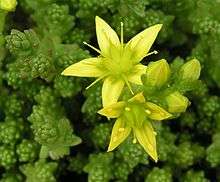
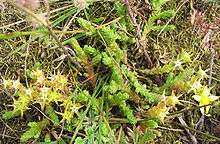
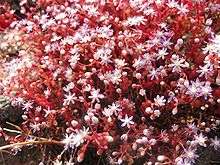
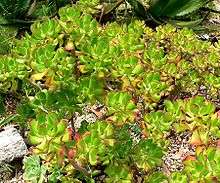
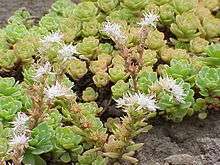

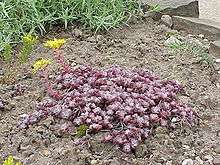
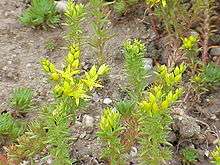
.jpg)